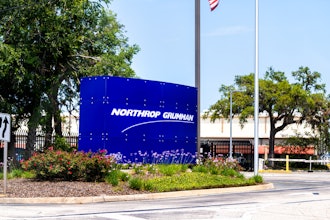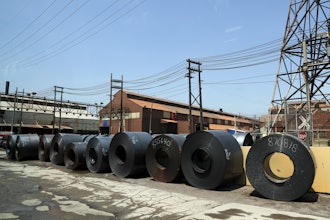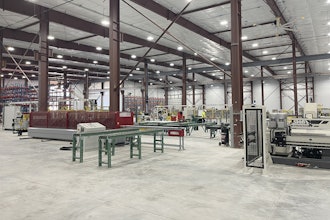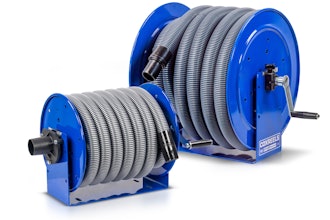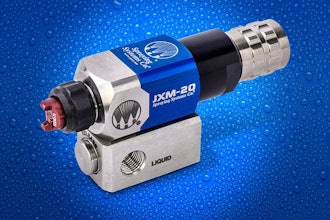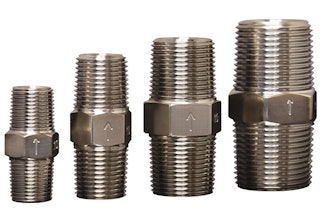Editor's note: This article originally appeared in the October 2015 issue of Food Manufacturing
Reliable, efficient machinery combined with technology plays a key role in the food processing industry. Regardless of the industry segment, equipment must be designed to withstand the rigors and safety constraints of the food processing industry. Bearings are critical components in food processing machinery, and decisions made by designers and engineers — such as lubrication, material and shielding options — are integral in the life and performance of bearings in these applications.
Regulatory environment and safety
The U.S. food processing sector is extensively regulated by state and federal agencies. Federal agencies dominate the regulatory oversight: USDA FSIS for the meat and poultry processing businesses and FDA for all other food processing businesses. State agencies also have an active role in overseeing food processing businesses within their respective states.
All materials used in the food processing process, including the lubricants, must comply with federal requirements. And, depending on the application and products, materials and components such as bearings used in machinery may even require USDA/FDA approval.
Lubrication
Lubricant selection is critical to bearing performance and life, yet it is often overlooked by designers and engineers. Bearing life in the harsh environments found in food processing depends on proper lubrication in terms of both type and amount. Thousands of greases and oils are available that are designed to function in a variety of conditions. Operating temperature is the primary consideration when selecting a lubricant. Temperature directly impacts the base oil’s viscosity, which in turn impacts the ability to support loads.
Lubricant selection not only depends on the operating conditions the bearing will face, but may also be subject to regulatory requirements. Manufacturers of food processing machinery are often required to use “food-grade” lubricants. These lubricant types are broken into categories based on the likelihood they will contact food. The USDA created the original food-grade designations — H1, H2 and H3 — and the designations are described as follows:
H1 lubricants are food-grade lubricants used in food processing environments where there is some possibility of incidental food contact.
H2 lubricants are lubricants used on equipment and machine parts in locations where there is no possibility that the lubricant or lubricated surface contacts food.
H3 lubricants, also known as soluble or edible oil, are used to clean and prevent rust on hooks, trolleys and similar equipment.
Lubricants should provide good wear and corrosion resistance. Lubricants used in high-temperature applications such as meat, poultry, fruit-vegetable and beverage processing should have high-temperature oxidation stability.
Machinery used in beef, pork and poultry processing is typically exposed to “wash down” conditions using high-pressure water and anti-bacterial solutions which are often caustic, or steam, which can displace the grease. To avoid grease displacement, grease with high resistance to water washout are used and fill 70-100% of the bearing (as opposed to a typical fill amount of ~30%). While this level of filling can negatively affect rotational speed, it significantly improves grease life.
H1 lubricants used in these environments typically have synthetic, hydrocarbon base oils with urea, polyurea or aluminum complex thickeners. H2 lubricants typically have mineral or PFPE base oils with calcium soap or PTFE thickeners. Polyurea greases typically perform well in smaller ball bearings.
Solid lubricants can be used in very demanding applications. These are oil-filled polymers, or grease and polymer mixtures that solidify once heated and cooled. Solid lubricants can eliminate problems with grease leakage and emulsification when water is present.
Due to the wide array of products along with price and availability, both a lubrication specialist and the bearing manufacturer should be consulted before making a final lubricant selection.
Materials
All bearings should be manufactured using components produced from high purity material. While bearings are most commonly produced from SAE 52100 chrome steel, for most food processing applications, martensitic stainless steel, similar to AISI 440C, is recommended. 400 series stainless steel offers the best combination of corrosion resistance and fatigue life.
For certain sizes of ball bearings, nitrogen-enhanced martensitic stainless steel is also available. This material is more expensive, but offers up to five times the corrosion resistance when compared to traditional “440C type” materials. This material also exhibits very low noise levels and extended fatigue life due to its fine structure that contains smaller chromium nitrides (as opposed to chromium carbides).
Bearing components such as shields, slingers and cages should be manufactured from AISI 302 or 304 stainless steel. While deep groove ball bearings can be manufactured from AISI 300 series steel, which has outstanding corrosion resistance when compared to martensitic 400 series steels, they typically are not used in food processing applications due to their compromised fatigue strength. Load ratings for ball bearings manufactured from 300 series austenitic steel are approximately 20% of the ratings for 400 series. However, if the applied loads are very light they could be considered.
If bearings are required to operate immersed in water or resist chemical attack, hybrid ball bearings can be used. The rings are produced from martensitic stainless steel, and the balls are ceramic-silicon nitride. The bearing cage can be produced from a fluoro-resin or Teflon, which provides lubrication. These bearings are maintenance free and extend life in these severe conditions.
Mounted bearings are used extensively in food processing equipment and conveyors. This type of bearing usually consists of a radial ball bearing, sometimes a roller bearing, mounted and held within a housing. The bearing inside is known as an insert. Various housing styles allow for different mounting arrangements. One of the more common housing configurations is known as a pillow block.
Insert bearings should be produced from 440C stainless steel. Other options to consider for the insert are AISI 52100 chrome steel bearings that are either zinc chromate plated or black oxide coated. Several options are available for corrosion resistant, food safe housings.
In the meat and poultry sectors, high strength housings are often required. Cast or ductile iron housings with electro less nickel plating offer strength and can withstand most wash downs with the added benefit of being cost effective. However, cast stainless steel, 300 series, is the best choice when facing high concentrations of chlorine or other chemicals in the wash down solutions. Thermoplastic housings are an effective alternative in high moisture environments with caustic wash down solutions. While they are not as strong, they are light weight and do not chip or flake as compared to a housing with plating.
Housing surfaces should also be smooth with flat mounting bases without recessed areas. This assists with effective wash down and eliminates the possibility of food by products or debris getting caught under the mounting surfaces which can lead to bacterial growth.
Seals
In food processing plants, bearings are continuously exposed to liquids and various types of particulate debris. Sealed or shielded bearings are the best option for keeping foreign debris out of the interior of the bearing and keeping lubricant in.
The most common bearing seal material is a nitrile rubber. This type of seal is typically Buna-N bonded to a steel insert. The seal is fixed into a groove in the outer ring. The maximum operating temperature is 240° F. This type of seal makes contact with the inner ring providing better protection in contaminated environments than a metal shield. However, this results in an increase in torque and reduces the maximum speed capability of the bearing, but in almost all cases is a design tradeoff that improves the product life.
Certain lubricants and chemicals react with rubber. Aside from the Buna-n and nitrile rubber material, other materials are available for higher temperatures and chemical resistance. These include FDA approved silicone rubber seals that can handle a maximum temperature of 400° F and Viton that has good chemical resistance and a maximum operating temperature of 400° F.
The seal construction can greatly improve its ability to function in extreme environments. Seals can be shrouded in metal, such as stainless steel or galvanized steel. Often called slingers, this type of seal is often found on mounted bearings and the metal shroud helps protect the rubber from abrasion.
The portion of the seal that contacts the inner ring of the bearing is known as the seal lip. Seals can be designed as single, double or triple lips. The seal lips flare out where the contact the ring provides effective protection against lubricant loss and wet or particulate contaminants. Triple lip seals provide the most protection, but also increase rotational torque substantially compared to single lip designs.
When lower torque is a design requirement, a non-contact rubber seal based on the labyrinth effect can be utilized. These seals function by creating a path the fluid or debris must navigate in order to penetrate the seal. In bearings, this is typically just a groove in the inner ring. A contact lip seal can be used very effectively in combination with a labyrinth design to provide excellent protection and low torque.
Teflon and glass reinforced PTFE seals are an excellent material choice in food processing applications. They have outstanding chemical resistance, high and low-temperature capability and exhibit less torque than rubber seals. However, depending on the type of bearing and their construction, these seals are not as robust and can be dislodged if hit directly with a high-velocity stream of fluid.
Keep in mind, the seals found on most types of bearings are not designed for immersion and fluid penetration will eventually take place. They offer excellent protection from particulate contaminants or a fluid splash and wipe down situation.
In the food processing industry, bearing life is a major factor contributing to uptime and reliability. The environments bearings encounter in these applications are extremely harsh. Bearings are selected based in operational loads and desired life, but designers must also give careful consideration to protecting bearings from corrosion and contamination and maximizing lubricant life.
As evidenced, there are a wide range of bearing options to take into account for optimal application performance. Food processing engineers and designers are advised to consult a bearing applications specialist for assistance with calculating environmental factors, load capacity, bearing life and attributes.
About the author
John Wallace is the Vice President of Operations at AST Bearings LLC., an ISO 9001:2008 certified company and a leading supplier of precision bearings and bearing related products. Visit www.astbearings.com for more information on their catalogue of more than 10,000 bearing products, lubrication services, engineering and design services, complimentary white papers, technical articles, 3D CAD models and more. AST’s ‘Value Beyond the Part’ initiative makes a team of tribologists and engineers available to work with you to find the right bearing for your unique food and beverage application.










